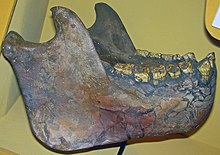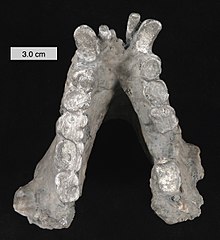Gigantopithecus
| Gigantopithecus | |
|---|---|

| |
| Reconstructed Gigantopithecus mandible at the Cleveland Museum of Natural History, Ohio | |
| Scientific classification | |
| Domain: | Eukaryota |
| Kingdom: | Animalia |
| Phylum: | Chordata |
| Class: | Mammalia |
| Order: | Primates |
| Suborder: | Haplorhini |
| Infraorder: | Simiiformes |
| Family: | Hominidae |
| Tribe: | † Sivapithecini
|
| Genus: | †Gigantopithecus |
| Species: | †G. blacki
|
| Binomial name | |
| †Gigantopithecus blacki von Koenigswald, 1935[1]
| |
Gigantopithecus (
Gigantopithecus has traditionally been restored as a massive, gorilla-like ape, potentially 200–300 kg (440–660 lb) when alive, but the paucity of remains make total size estimates highly speculative. The species may have been sexually dimorphic, with males much bigger than females. The incisors are reduced and the canines appear to have functioned like cheek teeth (premolars and molars). The premolars are high-crowned, and the fourth premolar is very molar-like. The molars are the largest of any known ape, and have a relatively flat surface. Gigantopithecus had the thickest enamel by absolute measure of any ape, up to 6 mm (a quarter of an inch) in some areas, though this is only fairly thick when tooth size is taken into account.
Gigantopithecus appears to have been a
Discovery
Research history

Gigantopithecus blacki was named by anthropologist
In 1955, a survey team that was led by Chinese palaeontologist
Confirmed Gigantopithecus remains have since been found in 16 different sites across southern China. The northernmost sites are
Classification
G. blacki

In 1935, von Koenigswald considered Gigantopithecus to be closely allied with the
Gigantopithecus is now classified in the
In 2019,
Cladogram according to Zhang and Harrison, 2017:[5]
Hominoidea (apes)
|
|
"G. bilaspurensis"
In 1969, an 8.6 million year old mandible from the
Description

Size
Total size estimates are highly speculative because only tooth and jaw elements are known, and molar size and total body weight do not always correlate, such as in the case of postcanine megadontia hominins (small-bodied primate exhibiting massive molars and thick enamel).[18] In 1946, Weidenreich hypothesised that Gigantopithecus was twice the size of male gorillas.[12] In 1957, Pei estimated a total height of about 3.7 m (12 ft). In 1970, Simons and American palaeontologist Peter Ettel approximated a height of almost 2.7 m (9 ft) and a weight of up to 270 kg (600 lb), which is about 40% heavier than the average male gorilla. In 1979, American anthropologist Alfred E. Johnson Jr. used the dimensions of gorillas to estimate a femur length of 54.4 cm (1 ft 9 in) and humerus length of 62.7 cm (2 ft 1 in) for Gigantopithecus, about 20–25% longer than those of gorillas.[19] In 2017, Chinese palaeoanthropologist Yingqi Zhang and American anthropologist Terry Harrison suggested a body mass of 200–300 kg (440–660 lb), though conceded that it is impossible to obtain a reliable body mass estimate without more complete remains.[5]
The average maximum length of the upper canines for presumed males and females are 21.1 mm (0.83 in) and 15.4 mm (0.61 in), respectively, and Mandible III (presumed male) is 40% larger than Mandible I (presumed female). These imply sexual dimorphism, with males being larger than females. Such a high degree of dimorphism is only surpassed by gorillas among modern apes in canine size, and is surpassed by none for mandibular disparity.[5]
Teeth and jaws
Like other apes, Gigantopithecus had a
In the upper jaw, the first premolar (P3) averages 20.3 mm × 15.2 mm (0.8 in × 0.6 in) in surface area, the second premolar (P4) 15.2 mm × 16.4 mm (0.60 in × 0.65 in), the first and/or second molars (M1/2, which are difficult to distinguish) 19.8 mm × 17.5 mm (0.78 in × 0.69 in), and the third molar (M3) 20.3 mm × 17.3 mm (0.80 in × 0.68 in). In the lower jaw, P3 averages 15.1 mm × 20.3 mm (0.59 in × 0.80 in), P4 13.7 mm × 20.3 mm (0.54 in × 0.80 in), M1/2 18.1 mm × 20.8 mm (0.71 in × 0.82 in), and M3 16.9 mm × 19.6 mm (0.67 in × 0.77 in). The molars are the biggest of any known ape.[5] Teeth continually evolved to become larger and larger.[23] The premolars are high-crowned, and the lower have two tooth roots, whereas the upper have three. The lower molars are low-crowned, long and narrow, and waist at the midline—which is more pronounced in the lower molars—with low-lying and bulbous cusps and rounded-off crests.[5]

The tooth enamel on the molars is in absolute measure the thickest of any known ape, averaging 2.5–2.9 mm (0.098–0.114 in) in three different molars, and over 6 mm (0.24 in) on the tongue-side (lingual) cusps of an upper molar.[22] This has attracted comparisons with the extinct Paranthropus hominins, which had extremely large molars and thick enamel for their size.[22][20] However, in relation to the tooth's size, enamel thickness for Gigantopithecus overlaps with that of several other living and extinct apes. Like orangutans and potentially all pongines (though unlike African apes) the Gigantopithecus molar had a large and flat (tabular) grinding surface, with an even enamel coating, and short dentine horns (the areas of the dentine layer which project upwards into the top enamel layer).[18] The molars are the most hypsodont (where the enamel extends beyond the gums) of any ape.[5]
Palaeobiology
Diet

Scale 3 cm (1.2 in)
Gigantopithecus is considered to have been a
The molar-like premolars, large molars, and long rooted cheeked teeth could point to chewing, crushing, and grinding of bulky and fibrous materials.
The 400,000–320,000 year old
In 1957, based on hoofed animal remains in a cave located in a seemingly inaccessible mountain, Pei had believed that Gigantopithecus was a cave-dwelling predator and carried these animals in.[30] This hypothesis is no longer considered viable because its dental anatomy is consistent with herbivory.[24] In 1975, American palaeoanthropologist Tim D. White drew similarities between the jaws and dentition of Gigantopithecus and those of the giant panda, and suggested they both occupied the same niche as bamboo specialists.[31] This garnered support from some subsequent researchers, but thicker enamel and hypsodonty in Gigantopithecus could suggest different functionality for these teeth.[22]
The species' reliance on barks and twigs for nutrition led to its demise.[32]
Growth
A Gigantopithecus permanent third molar, based on an approximate 600–800 days required for the enamel on the cusps to form (which is quite long), was estimated to have taken four years to form, which is within the range (albeit, far upper range) of what is exhibited in humans and chimpanzees. Like many other fossil apes, the rate of enamel formation near the enamel-dentine junction (dentine is the nerve-filled layer beneath the enamel) was estimated to begin at about four μm per day; this is seen in only baby teeth for modern apes.[20]
Protein sequencing of Gigantopithecus enamel identified
Pathology
Gigantopithecus molars have a high cavity rate of 11%, which could mean fruit was commonly included in its diet.[5][26] The molars from Gigantopithecus Cave frequently exhibit pitting enamel hypoplasia, where the enamel improperly forms with pits and grooves. This can be caused by malnutrition during growth years, which could point to periodic food shortages, though it can also be induced by other factors.[26] Specimen PA1601-1 from Yanliang Cave shows evidence of tooth loss of the right second molar before the eruption of the neighboring third molar (which grew slantedly), which suggests this individual was able to survive for a long time despite impaired chewing abilities.[10]
Society
The high levels of sexual dimorphism could indicate relatively intense male–male competition, though considering the upper canines only projected slightly farther than the cheek teeth, canine display was probably not very important in agonistic behaviour, unlike modern non-human apes.[5]
Palaeoecology

Gigantopithecus remains are generally found in what were subtropical evergreen broadleaf forest in South China, except in Hainan which featured a tropical rainforest. Carbon and oxygen isotope analysis of Early Pleistocene enamel suggests Gigantopithecus inhabited dense, humid, closed-canopy forest. Queque Cave featured a mixed deciduous and evergreen forest dominated by birch, oak, and chinkapin, as well as several low-lying herbs and ferns.[5]
The "Gigantopithecus
Extinction
Over the course of the Pleistocene, the environment-specialized Gigantopithecus showed signs of dietary changes based on dental morphologies in response to ecological pressure. Other
The extinction of the specialized Gigantopithecus and survival of Pongo weidenreichi plus Homo in the Middle Pleistocene is thought to have been the result of the former having struggled to adapt to major environmental changes compared to the latter two. P. weidenreichi likely was more flexible in seasonal dietary habits whereas Homo was a generalist and therefore was able to adapt to mixed habitats stemming from Middle Pleistocene environmental changes.[4] Some authors had suggested that H. erectus was a possible factor in the extinction of Gigantopithecus.[39] Human activity in southern China is known as early as 800,000 years ago but does not become prevalent until after the extinction of Gigantopithecus, so it is unclear if pressures such as competition over resources or overhunting were factors.[35] Zhang et. al. in 2024 suggested that there is no evidence of any archaic hominin involvement in the early extinctions of the Pleistocene of southern China.[4]
Some authors have suggested that Gigantopihecus may have survived into the early Late Pleistocene, though the evidence for this is limited.[40]
Cryptozoology
Gigantopithecus has been used in
See also
References
- ^ a b c von Koenigswald, G. H. R. (1935). "Eine fossile Säugetierfauna mit Simia aus Südchina" (PDF). Proceedings of the Koninklijke Akademie van Wetenschappen te Amsterdam. 38 (8): 874–879. Archived (PDF) from the original on 2017-12-12. Retrieved 2017-12-12.
- ^ "Definition of gigantopithecus | Dictionary.com". www.dictionary.com. Archived from the original on 2022-10-03. Retrieved 2022-10-02.
- ^ Tamisiea, Jack (10 January 2024). "The Biggest Ape That Ever Lived Was Not Too Big to Fail - Fossil teeth reveal Gigantopithecus was doomed by a changing environment and an inflexible diet". The New York Times. Archived from the original on 10 January 2024. Retrieved 11 January 2024.
- ^ from the original on 11 January 2024. Retrieved 11 January 2024.
- ^ PMID 28105715.
- ^ ISBN 978-0-521-66315-1.
- ISBN 0-13-096152-3.
- ISSN 0028-0712. Archived from the original on May 25, 2015.)
{{cite journal}}: CS1 maint: unfit URL (link - .
- ^ S2CID 130928802.
- ^ Broom, R. (1939). "The dentition of the Transvaal Pleistocene anthropoids, Plesianthropus and Paranthropus" (PDF). Annals of the Transvaal Museum. 19 (3): 303–314.
- ^ a b Weidenreich, F. (1946). Apes, Giants, and Man. University of Chicago Press. pp. 58–66.
- hdl:2246/298.
- ^ PMID 31723270.
- ISBN 978-1-4832-8925-0.
- ^ Cameron, D. (2003). "A functional and phylogenetic interpretation of the late Miocene Siwalik hominid Indopithecus and the Chinese Pleistocene hominid Gigantopithecus". Himalayan Geology. 24: 19–28.
- ^ Cameron, D. (2001). "The taxonomic status of the Siwalik late Miocene hominid Indopithecus (= Gigantopithecus)". Himalayan Geology. 22: 29–34.
- ^ PMID 17941103. Archived from the original(PDF) on 2016-03-03.
- .
- ^ PMID 14624748.
- PMID 8610161.
- ^ .
- ^ .
- ^ .
- PMID 18045651.
- ^ PMID 2236026.
- .
- PMID 25063565.
- .
- .
- .
- PMC 10794149. Retrieved 2024-01-11.
- ^ .
- .
- ^ PMID 19536242.
- S2CID 102353734. Retrieved 2022-11-17.
- ^ from the original on 14 November 2022. Retrieved 14 November 2022.
- S2CID 222217295.
- ISSN 1040-6182.
- S2CID 254413457.
- PMID 18514914.




